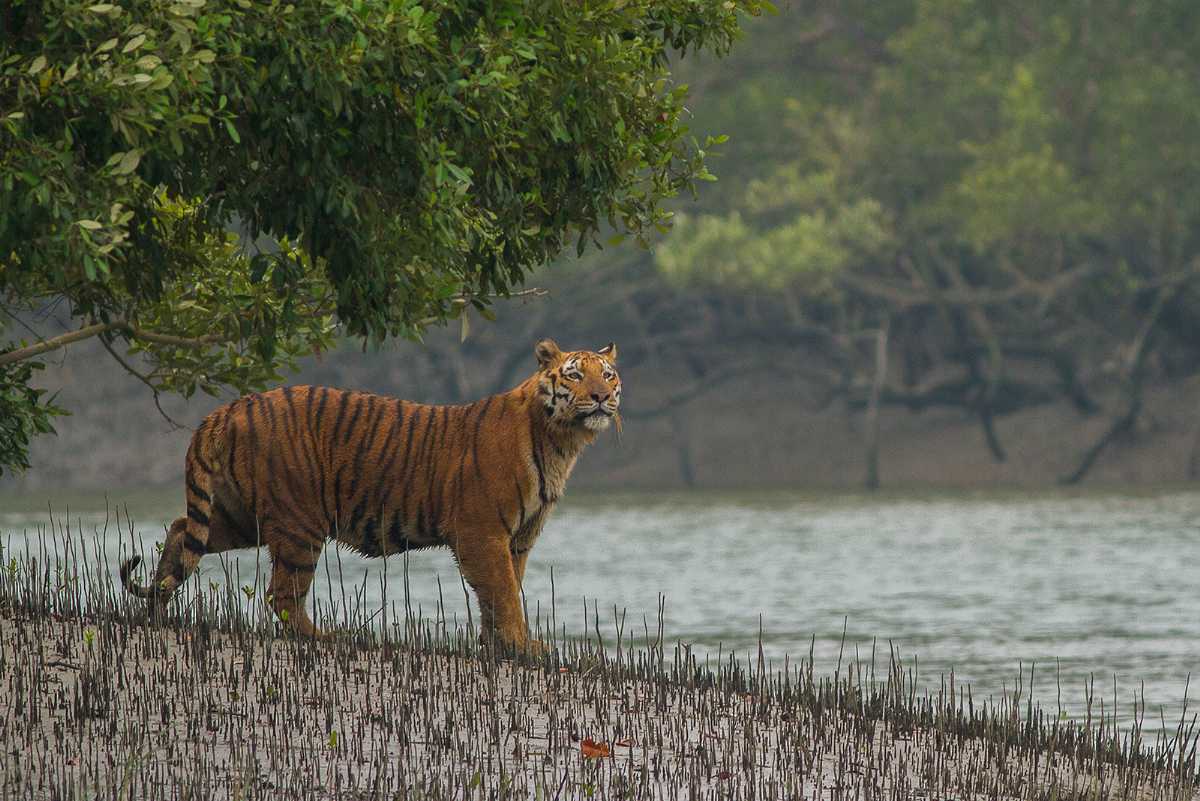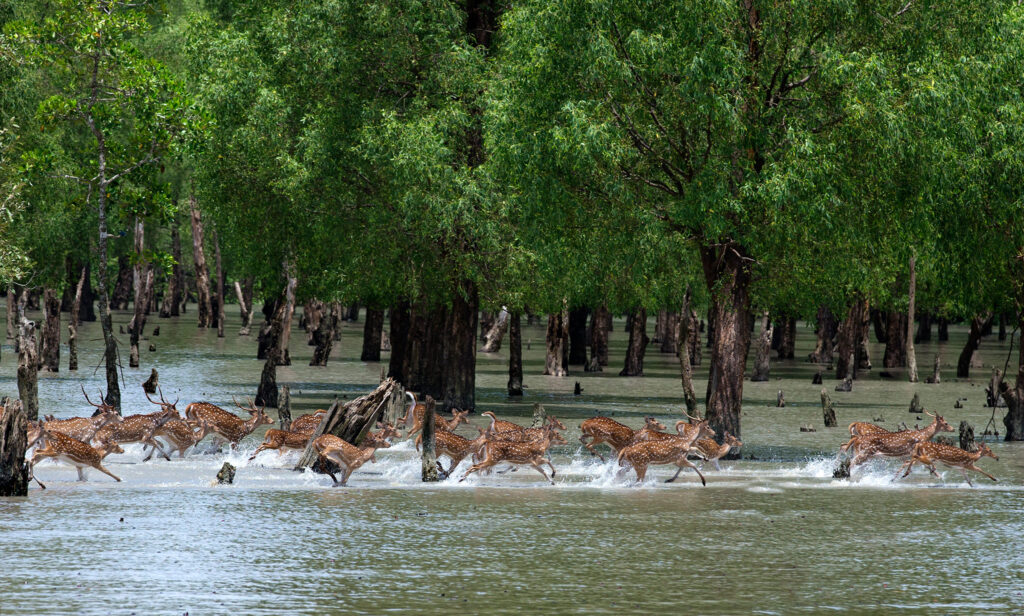Known for hosting the biggest mangrove forests in the world, Sundarbans National Park is located in West Bengal, India. It is also a Tiger Reserve and a Biosphere reserve that provides a complete nature’s circle to the tourist right from ‘Royal Bengal tigers’ to roaring rivers and beautiful estuaries. Sundarbans National Park is a part of Sundarban delta that is covered with Mangrove Forest and the largest population of the Bengal Tigers. It is a UNESCO world heritage site with a large variety of birds and reptiles including salt-water crocodile.
Shared between India and Bangladesh, the Sundarbans meaning beautiful forest, have been declared a UNESCO heritage site. This area has a silent charm that manages to amaze one with the simplicity and naturalness of its ecological balance in spite of offering habitat to some of the most dynamic and awe-inspiring flora and fauna. They are in fact the last remaining stands of the mighty jungles which once covered the Gangetic plain and the sustainability of this natural structure is pretty majestic. Since 1966, the Sundarbans have been a wildlife sanctuary, and it is estimated that there are over 400 Royal Bengal Tigers and about 30, 000 spotted deer in the area.
This forest has the largest number of Sundari trees. Sundarbans epitomize wilderness with its meandering rivers, springs, creeks and estuaries. It is a declared Tiger Reserve, home to the Royal Bengal Tiger- an almost extinct species who swim in the saline water and are often man-eating varieties.
Other endangered species in the Bioreserve are Batagur baska, King Crabs, Olive Ridley and Turtle. You can also find the jungle fowl, giant lizards, spotted deer, wild boar and crocodiles in these forests. The Siberian ducks are another famous attraction here. Besides this, there are over 64 varieties of Mangroves such as Goran, Genwa, Dhundal, Garjan, Kankra, Sundari and Passur. Make sure to hit the Nilkamalor Hiron Point and Katka viewpoints that offer fantastic views of animals in the wilderness. Also, enjoy the mud-flats called Chargheri Char where you can enjoy coastal trekking.
More on Sundarbans
Table of Contents
Safari in Sunderban National Park
 Being in the midst of large water bodies means Sundarban can offer you the cruising experience of a lifetime where with just a little luck, you can experience the Royal Bengal tiger swimming alongside your cruise boat. Both government and private cruising tours are available here, ranging from budget to luxury options.
Being in the midst of large water bodies means Sundarban can offer you the cruising experience of a lifetime where with just a little luck, you can experience the Royal Bengal tiger swimming alongside your cruise boat. Both government and private cruising tours are available here, ranging from budget to luxury options.Boat Safari
The government operated boat safaris are available in large and small sizes, large ones for longer durations and small ones for smaller durations. They are available in AC as well as Non-AC. The boat safari can be booked for one day and even for longer time periods 0f one week.
Timings
It starts at 08:30 AM and ends at 04:00 PM. Boats are not allowed inside after 06:30 PM. Both AC and Non-AC boats
Cruise
The 2 Night cruise operated by the West Bengal government takes you to Sudhanyakhali, Sajnekhali, Jhingakhali, and Dobanki watchtower. There is also a less expensive 1 Night tour which excludes a visit to the Jhingakhali tower. The tour is conducted in two boats, Chitralekha and Sarbajaya. The latter one is said to be the better option out of the two. The tours are conducted with a group of up to 50 people.
So, expect a large crowd and fewer chances of sighting wildlife as the boats can only pass through wide waterways because of their large size.
Timings
A 2N/3D tour will start from Kolkata at 08:00 in the morning from Kolkata and end on Day 3 at 05:30 PM, also in Kolkata.
Booking and Cost
You can book online on the website of West Bengal tourism. The cost depends on the part of the ship you book. An all-inclusive package starts from INR 4,840 for lower deck, INR 6,050 for Non-AC birth, INR 7,700 for AC birth, INR 6,600 for Cabin and INR 14,850 (2 PAX) for a couple.
Private Cruise Tours
Private cruise tours are also available, ranging from 2N/3D budget tours to 6N/7D luxury tours. The cost also varies with the type of amenities, facilities, and the requirements of the guest. Sundarban Chalo, Vivada Sundarban, Sundarban Houseboat, Help Tourism Sundarbans Jungle Camp, and Tour De Sundarban are some popular options with the tourists.
Timings
All cruise tours usually start at 8:00 in the morning and end around 5:00-5:30 in the evening.
Cost
The price can be as low as INR 2,000 per person and as high as INR 50,000 per person.
Private Boats
Privately run boat rentals are also an option if you want to explore the river waters for only a day.
Timings: Starts at 8:00 in the morning and end around 5:00-5:30 in the evening.
Cost
All inclusive food charges start from INR 950 per person, and overnight stay is charged extra at INR 600 per person. Expenses for the motorboat, forest entry fee, and video camera fee are over and above the food and overnight stay charges and have to be paid by the tourist to the forest department directly.
Geography
Watch Towers
Sudhanyakhali: Tigers, crocodiles, wild boars
Sajnekhali: Kingfisher, White Bellied Sea Eagle, Plovers, Lap-Wings, Curfews, Whimprel, Sandpipers, Pelican, Bono Bibi temple, Crocodile park, Mangrove Inspection Centre
Dobanki: Canopy walk, Cheetal
Burirdabri: Mud walk, Mangrove cage trail, molluscs, crabs
Netidhopani: Ancient Shiva Temple
Bonnie Camp: Scenic beauty, tigers, deer
Jhingekali: Tigers, Brahmini Kite Bird
Flora and Fauna
Flora
The vegetation in Sunderbans is a moist tropical forest with Mangroves dominating the flora. Multiple species of Mangroves are found here. Sundari tree (Heritiera fomes), which in all probability gave the forest its name characterizes the thick Mangrove growth. Other species of Mangrove found here are Gewa (Excoecaria agallocha), Keora (Sonneratia apetala), Dhundul (Xylocarpus granatum), Kankra (Bruguiera gymnorhiza), and Goran (Ceriops decandra).
Poresia Coaractata, Myriostachya Wightiana And Golpata are the species of Palm Trees found in the forest. Covers of Speargrass and Khagra grass are also found in the forest.
Fauna: Glowing Phytoplanktons: If you are taking a night safari through the waters, be prepared to behold the rare sight of a magical starry night, both underneath as well as above you. Sundarban waters are replete with tiny organisms called phytoplankton which glow in the dark. If you plan accordingly, on a Safari on a new moon night, you will see the waters lit up like blue fairy lights. Animals: Sunderban is particularly known for being the only Mangrove ecosystem in the world which harbours an entire population of Tigers. The tigers here have adapted themselves to the salty water and also become great swimmers. Due to a difficult hunting environment, anything that moves becomes prey in the eye of the Tiger, including human who set out into the jungle. Apart from tigers, other animal species found in Sundarban are Cheetal, Wild Boar, Small Indian Civet, Rhesus Macaque, Fishing Cats, Leopard Cats, Common Otter, and Black Finless Porpoise. Dolphins are also aplenty in the river water and two types of Dolphin, that is, Gangetic dolphin and Irrawady Dolphin are found here. Reptiles: Estuarine Crocodile(Crocodilus porosus), though endangered, is still present in Sundarban in good numbers. Snake population pervades the jungle as 57 out of 93 snake species in West Bengal are found here. Common among them are Common Cobra, Russel’s Viper, King Cobra, Indian Python, Common Krait, Rat Snake, Chequered Keelback, and Green Whip Snake. River Terrapin is a locally found species which has been given an endangered species. Water Monitor Lizard is another reptile with a decent population in the Sundarbans. Turtles, both freshwater and seawater are found here. Among the freshwater species, Indian Soft-shelled Turtle, Flapshell Turtle, and Spotted Pond Turtle are common. Olive Ridley, Hawksbill Turtle, and Green Sea Turtles are commonly found seawater species. Birds: The rich avifauna of Sundarban boasts of over 210 species of birds. A huge number of migratory birds visit the forest every winter. Flocks of Wader birds can be seen foraging near the mudflats and sandbanks. Some majorly sighted bird species are Oriental Honey Buzzard, Herons, Short Toed Eagle, Sandpipers, Whimbrels, Spoonbills, Stilts, Thick Knees, Green Shanks, Curlew, Osprey, Shikara, Brahminy Kite, Osprey, and Crested Serpent Eagle. Other species of birds include Green Pigeon, Cormorants, Seagulls, Egrets, Cuckoos, Sunbirds, Ducks, Geese, and Storks. It’s also known as Kingfisher’s Paradise because of the presence of 10 out 12 species of Kingfisher in the region. Fishes: Numerous rivers and creeks wind through the forests of Sundarban, and an abundance of fish and crustaceans is found in the flowing waters. Peripthalmus and Bolethalmus are amphibious fish species, most frequently seen swimming near mud banks and jetties. These rivers are also home to some endangered species such as Ganges Shark, Pondicherry Shark, and Shovel Nosed White Guitarfish. Indian Dog Sharks, Hammer Headed Sharks, Pale Edged Sting Rays, Bull Sharks, Black Tip Sharks, Pale Edged Sting Rays, and Black Edged Sting Rays are also found here in waters of Sundarban. Hilsa, Bhetki, Pomphret, Parshey, Gurjali, Topshey are other fish varieties commonly found here. Among the crab species, Ghost Crab and Fiddler Crabs are common inhabitants of these waters along with two primitive species of crabs known as Horseshoe Crab (Tachepleursgygus and Carcinoscropius rotundicauda). Tiger Prawns are also abundant and serve as a source of livelihood for the locals because of huge demand in the export market.
Islands
Lohachara island is one of the vanishing isles in the Sunderban delta region. It was once permanently flooded in the 1980s, then declared disappeared in 2006, and declared visible again in 2009. It was the only one of four permanently flooded islands inhabited by people.
Ghoramara island lies 92 km south of Kolkata and spreads in a minuscule area of 5 km. This island was also once populated with a huge number of local families but now faces complete submergence in water due to erosion and rise in sea water levels. Nonetheless, it is still inhabited by a population of 3,000 people.
Culture of the Forest Dwellers
The Mysterious Delta
The mysterious mangrove forests are home to the Royal Bengal Tiger and several other species of animals. Sundarbans is a replica of the miracles of nature and shows us the importance of the ecosystem. A trip to Sundarbans is thus, a perfect escape from the hectic life into the lap of Mother Nature. Apart from the natural beauty, the non-communal traditions of the local population in the region gives a strong message to take away home.
Restaurants and Local Food in Sundarbans
Suggested Itinerary
Day 2 – Start off early morning. Visit the watch towers in Sajnekhali, Sudyanakhali and Do Banki. The mangrove interpretation centre in Sajnekhali is a must-visit. These regions highlight different features of the huge jungle and are exciting to explore.






Be the first to write a comment.